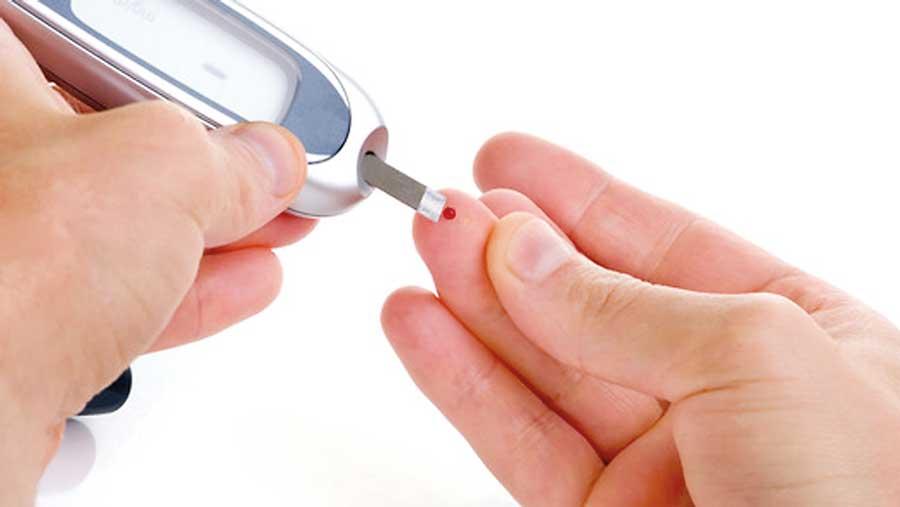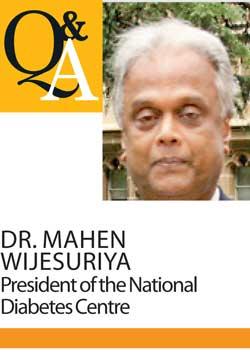18 Nov 2019 - {{hitsCtrl.values.hits}}

 Ranging as one of the leading causes of illnesses that affects the lives of many today, diabetes is a chronic health condition that has risen over the years with the global prevalence nearly doubling since 1980 according to United Nations. With the World Health Organization marking November 14 as the World Diabetes Day, and with the prevalence of diabetes affecting and rising among the young and the old alike, it is only timely that more light should be shed on this topic that affects the lives of many in modern times. In discussion with the Health Capsule, President of the National Diabetes Centre, Dr. Mahen Wijesuriya explained how diabetes could deteriorate one’s life while stressing on the importance of leading a healthy lifestyle, with the aim to reduce the risk of falling prey to diabetes.
Ranging as one of the leading causes of illnesses that affects the lives of many today, diabetes is a chronic health condition that has risen over the years with the global prevalence nearly doubling since 1980 according to United Nations. With the World Health Organization marking November 14 as the World Diabetes Day, and with the prevalence of diabetes affecting and rising among the young and the old alike, it is only timely that more light should be shed on this topic that affects the lives of many in modern times. In discussion with the Health Capsule, President of the National Diabetes Centre, Dr. Mahen Wijesuriya explained how diabetes could deteriorate one’s life while stressing on the importance of leading a healthy lifestyle, with the aim to reduce the risk of falling prey to diabetes.
According to the UN, “Diabetes is a major cause of blindness, kidney failure, heart attack, stroke and lower limb amputation. Healthy diet, physical activity and avoiding tobacco use can prevent or delay type 2 diabetes. In addition, diabetes can be treated and its consequences avoided or delayed with medication, regular screening and treatment for complications”.
Blood sugar levels
Explaining the biological aspect of the condition, Dr. Wijesuriya said that Diabetes is an illness where an increase in the blood sugar level takes place in the person concerned. This in return, in the long term tends to damage many organs of the body. “Diabetes is the only illness that damages the brain, the eyes, the heart, the kidneys and the nerves leading to stroke, blindness, heart attacks, kidney failure and amputation of the limbs. This set of problems arise because the excess blood sugar tends to harden the blood vessels that supply blood to all these organs and is affected through the blood stream by reducing or narrowing the blood flow to these organs. There are many drugs used to combat blood sugar levels and bring it back to normal to protect the person. It is not only Metformin but also Sulphonylureas, Sitagliptin to name some that have come in to the market to combat the disease” explained Dr. Wijesuriya.
Prevention of the illness
Highlighting the need to adopt to preventive measures before the illness is diagnosed, Dr. Wijesuriya explained that these preventive measures to be adopted include lifestyle modifications such as setting up a correct dietary pattern, exercise on a regular basis leading to the control of one’s body weight and combatting mental stress. Its medication comes into play to treat the condition only after the preventive measures are installed. This type of preventive methods is first employed as treatment to patients who are ailing with type 11 diabetes also known as the adult onset of diabetes.
Treatment
Explaining that insulin should be used only after the basic lifestyle changes have been installed and when oral medication has not effectively helped in the normalization of blood sugar levels, Dr. Wijesuriya went on to explain on the second category of diabetes known as the juvenile onset of diabetes, commonly known as type 1 diabetes, where insulin is lifesaving and has to be administered from the point of diagnosis and throughout the lifetime of the patient.

“Type 1diabetes can arise from the first year of life itself. Usually, type 1 diabetes occurs in the first twenty years of life. Thankfully, it is rare in our part of the world and occurs in only 1-5% in countries such as ours, whereas it occurs up to 10% in the Nordic countries such as Sweden, Denmark and Norway. Managing such patients is difficult and needs constant attention and estimation of blood sugar levels with multiple injections per day whereas in type 11 or adult onset of diabetes, the treatment is lifestyle changes followed by oral medication, and then insulin. Such type 11 illness however is occurring in epidemic proportions today in about 10% of our population, which amounts to nearly four million patients in Sri Lanka” he explained.
“Diabetes is a health problem of huge scale in our society and is attributed to overweight and obesity on one hand, and living under stressful conditions mentally. Dietary pattern should be normalized in those showing tendency in blood sugar levels by eating natural food which has a high fiber content. Namely, cereals, legumes, vegetables and fruits supplemented by fish and chicken should be added to the diet. However, it is better to avoid high fat containing food such as beef, mutton, pork and fried food items as much as possible” Dr. Wijesuriya explained.
When asked if it would be possible to determine a vulnerable age group, he said that presently, there is no age barrier when it comes to ailing from diabetes. Though earlier, type 11 was contracted by those who are above the age of 40, now it occurs on much younger people. Hence, now diabetes is a chronic disease that affects the young and the old alike.
Take home message
“The message to our people is, stick to healthy eating habits, engage in an exercise routinely, followed by accepting life in a realistic way; accepting that everything changes and that we are faced with an impermanent state. We also need to bear in mind that failure of expectations gives rise to stress. The answer to this is to be happy with what you have got in life”, Dr. Wijesuriya concluded.
18 Apr 2024 19 minute ago
18 Apr 2024 33 minute ago
18 Apr 2024 50 minute ago
18 Apr 2024 1 hours ago
18 Apr 2024 2 hours ago